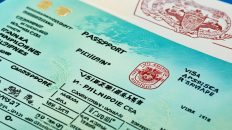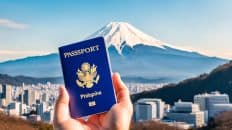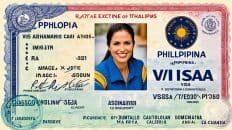Are you married to a Filipino citizen and dreaming of living in the Philippines? There’s a visa just for you! Our guide will cover everything about the 13A Visa Philippines, also known as the Conversion to Non-Quota Immigrant Visa by Marriage. You’ll learn how it enables you to stay in the Philippines long-term. We’ll go over the application steps, fees, and more. Ready to start this exciting journey? Let’s get going!
Key Takeaways:
- Learn about the 13A Visa Philippines, which allows a foreign spouse to reside in the country on a long-term basis.
- Understand the requirements for the 13A visa, including necessary documents and fees.
- Explore the step-by-step application process and the three methods of applying for the visa.
- Discover the benefits of the 13A visa, such as the right to live and work in the Philippines without restrictions.
- Get insights into the renewal process and the importance of compliance with the Bureau of Immigration guidelines.
How to Apply for a 13A Visa in the Philippines
If you’re thinking about getting a 13A visa in the Philippines, here’s what you need to know. Following a simple process can help you apply without stress. Let’s look at the steps to apply for a 13A visa:
- Obtain the Checklist with complete documentary requirements from the Bureau of Immigration (BI) website or the Public Information and Assistance Unit (PIAU) at the BI Main Office.
- Fill out the application form and gather all the necessary documents required for submission.
- Submit your documents for pre-screening to the Central Receiving Unit (CRU).
- Pay the required fees and obtain a copy of the official receipt.
- Attend a hearing at the Bureau of Immigration.
- Proceed to the Image and Fingerprint Capturing Counter to complete the ACR I-Card application.
- Check the BI website regularly to track the status of your visa application.
- Once your visa application is approved, submit your passport for visa implementation.
By carefully following these steps, you can make your 13A visa application process easier in the Philippines. It’s important to keep updated with any new information from the Bureau of Immigration. This way, you’ll avoid any delays or issues.
“Applying for a 13A visa in the Philippines is a straightforward process if you follow the necessary steps and provide all required documents. By staying organized and attentive to detail, you can increase your chances of a successful application.”
Fees and Costs for a 13A Visa in the Philippines
The cost of a 13A visa in the Philippines can change. As of March 2014, the fee is Php 8,620.00 for the main applicant. There are also fees for dependent spouses and children under 21.
Remember, the Alien Certificate of Registration (ACR) I-Card is extra. It costs US $50 for one year.
The 13A visa fees may update, so always check with the Bureau of Immigration. They will give you the latest info on fees and how to pay.
The 13A visa is good for one year and must be renewed yearly. Renew by submitting needed documents and paying fees. Make sure to renew before your visa expires to keep your status legal in the Philippines.
Fees for a 13A Visa in the Philippines
| Applicant | Fee |
|---|---|
| Principal Applicant | Php 8,620.00 |
| Dependent Spouse | Additional fee |
| Unmarried Children below 21 years of age | Additional fee |
| ACR I-Card (one-year validity) | US $50 |
The fees in the table are from March 2014 and might be old. It’s best to check with the Bureau of Immigration for current fees.
Keeping your 13A visa current is crucial for your legal status in the Philippines. Remember to submit documents and pay fees in time. Doing so lets you keep enjoying 13A visa benefits.
Eligibility for a 13A Visa in the Philippines
To get a 13A visa in the Philippines, you must follow some rules. You must be married to a Philippine citizen in a real and legal way. Plus, you must be 18 or older with a clean record, showing you’re a good person.
Your unmarried kids under 21 can apply with you. But you must prove they are really your children.
It’s very important to meet these requirements. Doing so helps your 13A visa application in the Philippines succeed.
Required Documents for a 13A Visa in the Philippines
To apply for a 13A visa in the Philippines, you’ll need specific documents. These are crucial for proving your eligibility. Make sure to have everything ready for a smoother application.
Here are the required documents for a 13A visa application:
- A valid passport: It should have at least six months of validity.
- A completed application form: Make sure to fill it out fully and accurately.
- The applicant’s marriage certificate or marriage contract: This proves your marital status and relationship with your Filipino spouse.
- The applicant’s birth certificate or a certified true copy of BI-issued Identification Certificate as a Filipino citizen of the Filipino spouse: It confirms your identity and your spouse’s Filipino citizenship.
- A photocopy of the Filipino spouse’s valid government-issued ID: A passport or driver’s license copy is needed.
- A photocopy of the applicant’s passport bio-page and latest admission with valid authorized stay: Include a copy of your passport’s bio-page and latest entry stamp/visa.
- A valid police clearance from the applicant’s country of origin or residence: This proves you have no criminal record.
- A Bureau of Immigration (BI) Clearance Certificate: It’s issued by the Bureau of Immigration and confirms your immigration status.
Depending on your situation, you might need additional documents, like those for dependent children. Check with the Bureau of Immigration or an accredited agency to be sure you have everything needed.
Keep all original documents safe and provide copies as required. Being organized and thorough makes the process smoother and improves your chances for approval.
With the right documents, you’re ready for the 13A visa application. Gather and check all your paperwork carefully, then submit it to the authorities for processing.
Financial Requirements for a 13A Visa in the Philippines
When you apply for a 13A visa in the Philippines, you need to know about the money part. The Bureau of Immigration wants you to show you can support yourself and anyone coming with you. You’ll need to share proof of your finances.
Showing you have enough money can be done in several ways. You can show bank statements, income tax returns, or work contracts. These documents prove you can handle your living costs. These costs include housing, healthcare, schooling, and more.
The exact money needed can change based on your situation. The Bureau of Immigration decides this. It’s smart to talk to an immigration lawyer or the Bureau directly. They can tell you what you need to show.
| Financial Requirements | Details |
|---|---|
| Bank Statements | Applicants should provide bank statements from their personal accounts to demonstrate sufficient funds for living expenses. |
| Income Tax Returns | Recent income tax returns can serve as proof of a stable income source and financial capacity. |
| Employment Contracts | Applicants who are employed in the Philippines can provide employment contracts that guarantee a steady salary. |
Make sure your financial papers are right, current, and follow what the Bureau of Immigration needs. If your financial proof isn’t enough, your visa might be delayed or denied.

Why Financial Requirements Matter
The 13A visa’s financial rules help make sure foreign spouses and dependents can live well in the Philippines. They won’t strain the local resources. Showing you have enough money means you can support yourself and help the country.
These rules also protect against exploitation or abuse by ensuring applicants have the right financial intentions. Plus, it makes sure you and your family can get important services and help.
“By demonstrating financial stability, applicants show their ability to support themselves and contribute positively to the country.”
Getting your financial documents in order is key. This meets the Bureau of Immigration’s rules. Getting advice from a pro can make it easier to meet all financial needs. This can help your visa application succeed.
Medical Requirements for a 13A Visa in the Philippines
Applying for a 13A visa in the Philippines requires meeting certain medical needs. This ensures the health and safety of the applicant while in the country.
A medical clearance certificate is one key requirement. It must come from a medical facility accredited by the Department of Health in the Philippines. This certificate confirms that the applicant is healthy and has no contagious diseases.
The certificate should have a recent chest X-ray result. This X-ray should be taken within the last six months to check lung health. A lab report for HIV/AIDS is also needed to confirm the applicant’s overall health.
Meeting these medical requirements is important. It shows that the applicant won’t be a health risk to others in the Philippines. It’s best to get the necessary medical exams and certificates from an accredited facility before applying for the visa.
| Medical Requirements for a 13A Visa in the Philippines |
|---|
| Medical Clearance Certificate from a Department of Health-accredited medical facility in the Philippines |
| Chest X-ray taken within the last six months |
| Laboratory report for HIV/AIDS |
Meeting these medical requirements makes the visa application process smoother. Applicants can also feel confident about their health.
Police Clearance Certificate for a 13A Visa in the Philippines
Getting a 13A visa in the Philippines means you need a police clearance certificate. This certificate proves you have no criminal record. It’s a key part of your visa application.
The Philippine Embassy or Consulate must authenticate your police clearance certificate. This step checks the certificate’s validity. It makes your background check credible.
The police clearance certificate ensures you’re safe for the Philippines. It shows you’re not a threat to its people. This safety check is crucial.
To get this certificate, you must reach out to your home country’s law enforcement. You’ll need to fill out a form, provide fingerprints, and maybe pay fees. The time it takes to get this document can vary widely.
After you get the police clearance, take it to the Filipino Embassy or Consulate. They’ll make sure it’s real. They’ll stamp or seal it to prove it’s authentic.
This certificate is very important for your visa. It shows you respect the law. And it helps keep the Philippines safe.
Tips for Obtaining a Police Clearance Certificate:
- Contact the law enforcement agency where you live to learn how to get a police clearance certificate.
- Give all the right details on your application – like your full name and birthday.
- Do exactly as the law enforcement agency tells you about fingerprinting, fees, and any needed documents.
- Remember, getting the police clearance certificate can take a long time, sometimes weeks or months.
“The police clearance certificate is a vital document in the 13A visa application process as it helps ensure the safety and security of both the foreign applicant and the Filipino community in the Philippines.”
Three Methods to Obtain a 13A Visa in the Philippines
Obtaining a 13A visa in the Philippines involves three main methods. Each method suits different needs and situations. Choosing the right option depends on your personal circumstances and preferences.
Method 1: Personal Filing with the Philippine Bureau of Immigration
First, you can file your 13A visa application directly with the Philippine Bureau of Immigration if you’re in the Philippines. This method gives you full control over your application. It offers convenience.
Method 2: Hiring an Accredited Agency
Another choice is using an accredited agency for your 13A visa application. This is great if you want experts to handle your application. They ensure all documents are submitted right.
Method 3: Personal Filing with the Philippine Embassy or Consulate
Not in the Philippines? File your 13A visa with the Philippine Embassy or Consulate in your home country. This way, you can start your application without visiting the Philippines first.
Think carefully about each option. Decide based on what fits your situation best. Whether you choose to file yourself, use an agency, or go through the embassy, make sure to meet all requirements. Include correct documents to boost your application success.
| Method | Advantages |
|---|---|
| Personal Filing with the Philippine Bureau of Immigration |
|
| Hiring an Accredited Agency |
|
| Personal Filing with the Philippine Embassy or Consulate |
|
Choose your application method wisely. Always prepare and submit all required documentation. Follow all provided instructions and stick to the guidelines. Doing so will help you secure your 13A visa. It opens up the chance to live and work in the Philippines with your Filipino spouse.
Benefits of a 13A Visa in the Philippines
The 13A visa in the Philippines is a big win for foreign spouses. It lets the foreign partner live and work there as long as they’re married to a Filipino citizen. They can also add their spouse and kids under 21 to their visa. This helps keep families together.
A 13A visa opens many doors for the foreign spouse in the Philippines. They can start bank accounts, invest freely, and get jobs. This helps them grow professionally and financially. Working in the Philippines also lets them contribute to the economy and gain valuable experience.
Having a 13A visa means no more visa renewal headaches. It makes life easier and reduces stress from paperwork. With this visa, the foreign spouse can truly settle in the Philippines.
“Having a 13A visa in the Philippines not only grants long-term residency, but it also opens up a world of possibilities and opportunities for foreign spouses, enabling them to fully embrace their new life in the Philippines.”
Access to Services and Privileges
A 13A visa gives foreign spouses many benefits in the Philippines. They can open bank accounts, get loans, and more. This brings financial stability and convenience. The visa also makes it possible for them to buy property in the Philippines.
This visa ensures the family has access to education and healthcare. Kids can go to local schools and universities. This lets them learn and experience Filipino culture. The visa holder and their family also get access to good healthcare services.
| Benefits of a 13A Visa in the Philippines | Details |
|---|---|
| Long-term residency | The visa allows foreign spouses to live in the Philippines without the need for continuous visa extensions. |
| Employment opportunities | Foreign spouses can pursue employment in the country without restrictions, supporting their financial stability and professional growth. |
| Access to financial services | The visa enables foreign spouses to open bank accounts, make investments, and engage in financial activities in the Philippines. |
| Property ownership | Foreign spouses can purchase real estate properties and establish a permanent residence in the Philippines. |
| Access to education and healthcare services | The visa grants access to quality education for children and the Philippine healthcare system for the entire family. |
Application Process for a 13A Visa in the Philippines
The application process for a 13A visa in the Philippines is clear and has several steps. Let’s look at what you need to do:
- Gather Required Documents: First, get all documents ready for your application. This includes the application form, supporting documents, and any extra requirements from the Bureau of Immigration.
- Choose Application Method: You can apply in three ways. Apply in person at the Bureau of Immigration, use an accredited agency, or go to the Philippine Embassy or Consulate in your country.
- Submit Application: After collecting your documents, submit them. If applying in person, visit the specified office. If using an agency or Embassy/Consulate, follow their guidelines.
- Processing and Interview: They will check your documents and evaluate them. You might need to attend an interview to check if you’re eligible for the 13A visa.
- Visa Issuance: If they approve your application, you’ll get your 13A visa. This lets you enter the Philippines and live with your Filipino spouse.
Remember, the details and requirements for the application can change. So, it’s best to look at the Bureau of Immigration’s official website or get help from reputable agencies for the latest information.
“The application process for a 13A visa in the Philippines helps qualified applicants. By following the steps and submitting the needed documents, you can live your dream with your Filipino spouse.”
Processing Time for a 13A Visa in the Philippines
Applying for a 13A visa in the Philippines requires knowing the processing time. How long it takes can change based on the Bureau of Immigration’s workload and your situation. Usually, it takes several months to process a 13A visa.
For a smooth process, apply early. Submit your application 2-3 months before you plan to travel to the Philippines. This gives enough time for processing.
The Bureau of Immigration will review your application and check your documents. They will also do necessary background checks. You must stay patient as processing times can differ. Do not make travel plans until you have your visa.
If you’re worried about your application’s status, visit the Bureau of Immigration’s website. They provide updates on their workload and potential delays.
Additional Tips for a Smooth Processing Time:
- Make sure all your documents are complete and correct before applying.
- Your passport should be valid for your whole stay in the Philippines.
- Give any extra documents the Bureau of Immigration asks for.
- Quickly answer any requests from the Bureau of Immigration.
- Getting help from a trusted agency or immigration lawyer is a good idea. They can make sure everything is correct.
Following these tips and giving yourself plenty of processing time can help. It can lead to a successful application and an easy move to your new life in the Philippines.
Working in the Philippines with a 13A Visa
Foreign spouses with a 13A visa can work in the Philippines. But, they must know about some work limits with a spouse visa. They must follow the country’s labor laws strictly.
In some jobs, they’ll need to get special work permits or licenses. This shows they have the right skills for the job. They should talk to the right government offices or get expert advice.
Getting the correct permits shows you want to work the right way in the Philippines. It makes sure everyone is treated fairly at work. It helps create a good work environment for everyone.
When foreign spouses follow the rules, they can enjoy working in the Philippines with a 13A visa. They get to help the local economy, gain work experience, and support their families.
They can look for jobs or start their own business in many areas. It’s important to learn about the job market and rules in the Philippines.
Benefits of Working in the Philippines with a 13A Visa
- Access to a wide range of employment opportunities
- Eligibility for local employment benefits and protections
- Opportunity to gain valuable work experience in the Philippines
- Potential for career growth and development
- Ability to support oneself and dependents financially
- Contribution to the local economy
To have a good work experience, it’s key to follow labor laws and regulations. This includes paying taxes, understanding work contracts, and following workplace rules. Keeping up with labor law changes is also critical for success.
Foreign spouses with a 13A visa have a chance to help the Philippines grow. They can find job satisfaction and financial security at the same time.
Validity of a 13A Visa in the Philippines
The 13A visa in the Philippines is good for one year at first. It can be renewed each year if you keep meeting the visa conditions. This includes being in a valid marriage with a Filipino citizen. To renew, you must submit all needed documents and pay fees. Make sure to renew before the visa expires to avoid problems in the Philippines.
Process for 13A Visa Renewal
To renew a 13A visa in the Philippines, there are steps to follow:
- Collect the documents needed for renewal. This includes a valid marriage certificate, a filled-out application form, and proof of financial stability.
- Check the Bureau of Immigration website for new guidelines and forms.
- Hand in the application form and supporting documents at the office or center. Make sure your documents are complete, accurate, and up-to-date.
- Pay the renewal fees as told by the Bureau of Immigration. Fees can change, so it’s best to check for the latest info.
- Wait for your renewal application to be processed. This could take weeks or months, depending on how busy they are and other factors.
- After the renewal is okayed, you’ll get a new 13A visa. It’s usually valid for another year.
Make sure to start the renewal process early. This way, you have enough time for processing and dealing with any delays.
| Document Checklist for 13A Visa Renewal | Additional Notes |
|---|---|
| Valid marriage certificate | Make sure your marriage certificate is current and legally recognized in the Philippines. |
| Completed application form | Always use the latest form from the Bureau of Immigration’s website. |
| Proof of financial stability | Show bank statements, income tax returns, or other proof of finances to support your stay in the Philippines. |
| Passport | Your passport should be valid for six months beyond your stay. |
| Photocopies of previous visa pages | Include copies of your past 13A visa and other relevant passport pages. |

Note: The renewal requirements and process might change a bit depending on your situation and current policies. Always check with the Bureau of Immigration and get professional advice if needed.
Important Considerations for a 13A Visa in the Philippines
Applying for a 13A visa in the Philippines requires careful thought. It’s vital to know the application’s needs and steps to ensure everything goes smoothly. Collecting all needed documents and following the Bureau of Immigration’s rules are keys to a proper application.
Keep these essential points in mind for your 13A visa application:
- Familiarize yourself with the requirements: Start by getting to know the 13A visa’s requirements well. Learn about who can apply, what you need financially, and the documents you must have.
- Seek professional assistance: Getting help from professionals or trusted agencies is a wise choice. They can lead you right through the application, give current info, and check you meet all demands.
- Prepare all necessary documents: It’s important to have all documents ready. You’ll need things like marriage and birth certificates, passports, and clearances. Make sure every document is complete, real, and up-to-date.
- Adhere to application guidelines: Following the Bureau of Immigration’s rules carefully is important. Fill the application correctly, pay the fees, go to interviews or hearings, and submit your application on time.
- Be aware of processing times: The time it takes to get a 13A visa changes based on the Bureau’s schedule and your application’s details. To avoid stress, apply well before your planned trip to the Philippines.
Remembering these points and being well-prepared can boost your chances of getting a 13A visa. Make sure your application is thorough and accurate.
Conclusion
Getting a 13A visa in the Philippines is a big step for foreign spouses. It means they can live and work there with their Filipino partner. This visa lets them start a new life together in the lovely islands of the Philippines.
The application process for a 13A visa has several steps. You must meet the eligibility, submit the needed documents, and pay the fees. Following the Bureau of Immigration’s rules closely is key to a successful application. Getting professional help can make it easier.
With a 13A visa, life in the Philippines can be rewarding for foreign spouses. They can enjoy the rich culture, stunning places, and make wonderful memories. Whether working, starting a business, or enjoying local life, the 13A visa offers many chances for a better future.














Add comment